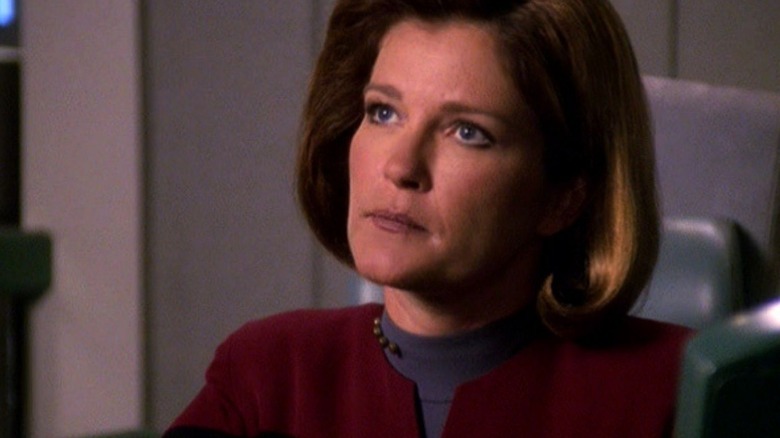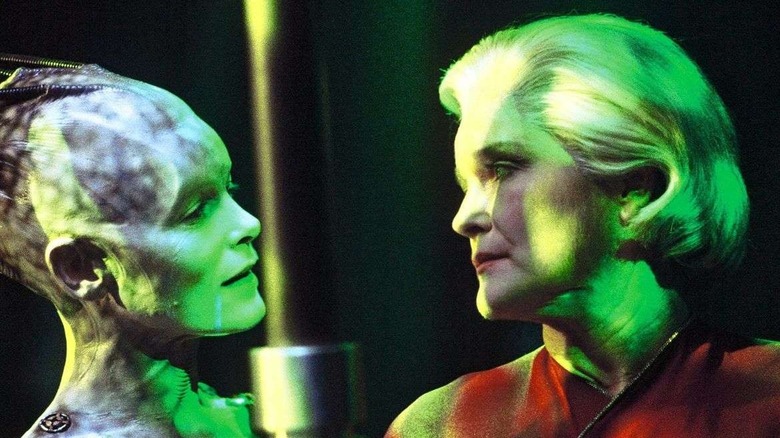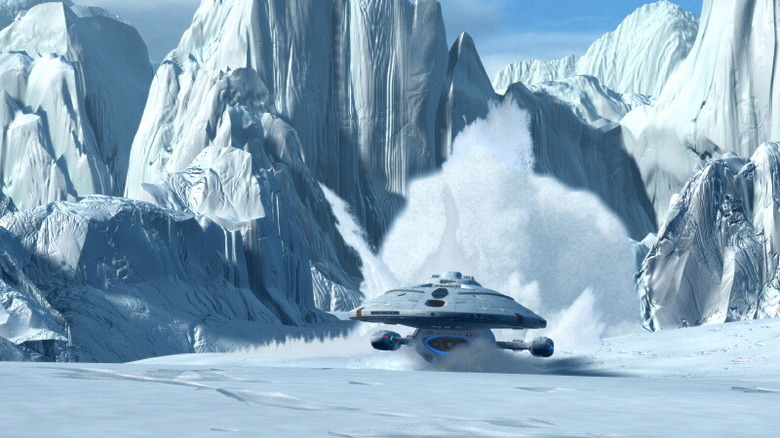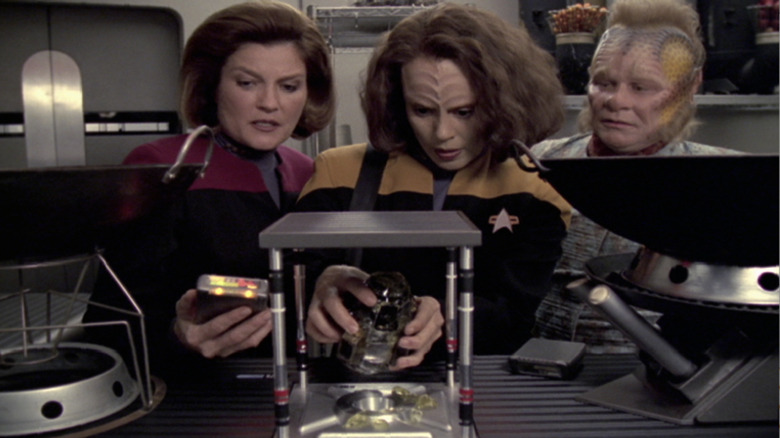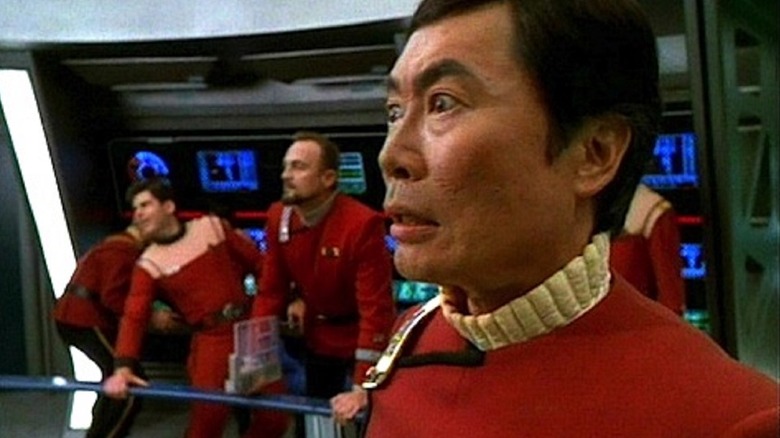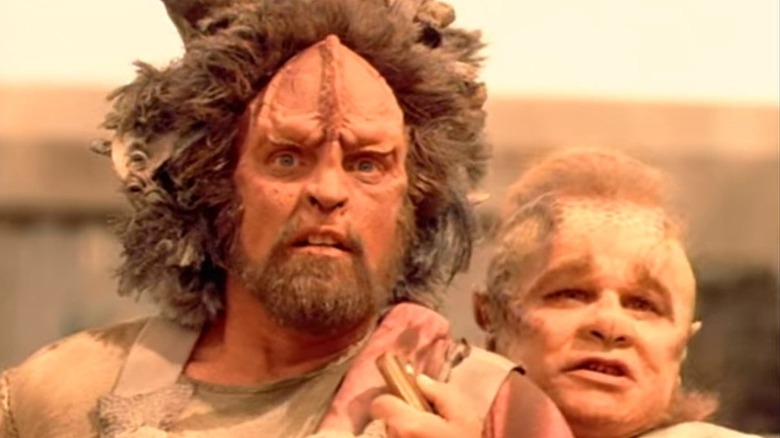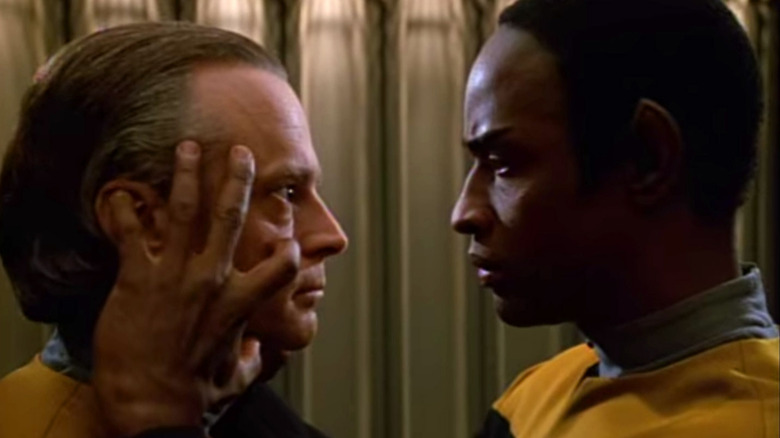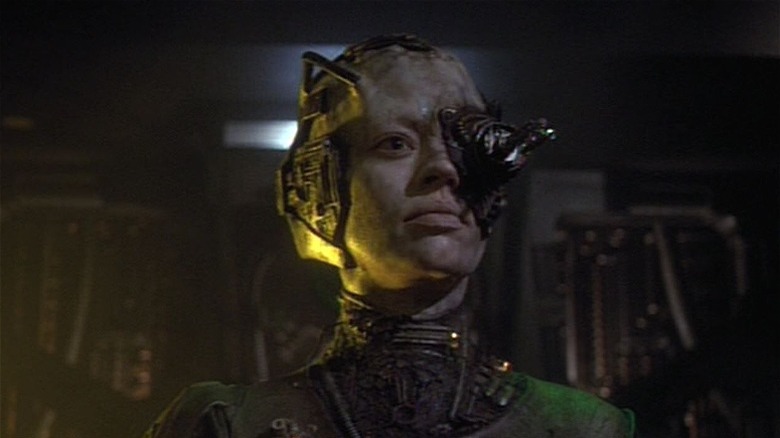Every Season Of Star Trek: Voyager Ranked Worst To Best
When "Star Trek: Voyager" premiered on Monday, January 16, 1995, it didn't just mark the launch of the fourth live-action "Star Trek" series. Its broadcast also marked the launch of UPN, Paramount's stab at establishing a fifth American television network after CBS, NBC, ABC, and FOX.
Picking "Voyager" for this important corporate duty was, to borrow a phrase, flawlessly logical. At the time, executives at Paramount saw the 1960s science fiction program and its spin-offs as so important to the studio that they reportedly referred to it as "the franchise." Indeed, with "Star Trek: Deep Space Nine" in the midst of its third successful season in first-run syndication and "Star Trek: The Next Generation" having made the jump to the big screen with the box office success of "Star Trek Generations," the "Star Trek" franchise was at an all-time high.
Almost 30 years later, interest in "Voyager" remains high, with characters from the series featured in prominent roles on "Star Trek: Lower Decks," "Star Trek: Prodigy" and "Star Trek: Picard." A crowdfunding campaign for a retrospective "Voyager" documentary successfully raised more than $1.3 million from nearly 12,000 backers. And many fans who didn't love the show at the time have developed a new appreciation for "Voyager."
In light of all that renewed interest in "Voyager," let's take a look at the show's seven seasons, which originally ran from 1995 until 2001, and see how they stack up against one another, from worst to best. We'll highlight specific episodes that characterize each season, but won't discuss every one — after all, there were 172 of them!
7. Season 7
They saved the worst for last. Season opener "Unimatrix Zero, Part II" all too neatly resolves the previous season's cliffhanger, but ends with an intriguing premise: a Borg civil war is brewing. The first of many empty promises. "Repression" seems like it will finally confront the fact that a quarter of the Voyager's crew are former Maquis, terrorists in the eyes of the Federation. Instead of examining this long-dormant dynamic, however, the episode veers off into a silly mind-control plot that is easily resolved and utterly without consequences.
Even the season's best installment, "Author, Author," dealing with The Doctor (Robert Picardo) and his pursuit of holographic rights, feels like a warmed-over version of "The Next Generation" episode "The Measure of a Man" and derivative of earlier episodes like "Living Witness" or "Tinker Tenor Doctor Spy."
And lastly, there's "Endgame." The out-of-left-field romance between Seven of Nine (Jeri Ryan) and Commander Chakotay (Robert Beltran) is awkward and unconvincing. Alice Krige reprises her role as the Borg Queen for the first time since "Star Trek: First Contact," but is utterly wasted. There's a disjointed and obligatory action finale. "Hull breaches on decks six through twelve!" shouts Ensign Kim (Garrett Wang), going through the motions. That much of the final episode is spent in an alternate future soon to be erased by the reset button of temporal intervention, rather than truly confronting what it will mean for these characters to finally return home, is a perfect distillation of the show's worst impulses.
6. Season 5
Season 5 is the epitome of conservative and unambitious television. There are good, even great episodes here, but they're trapped in an episodic formula with a perpetual status quo.
Consider "Timeless," the best episode of the season and a series standout. It has a cracking teaser (Voyager frozen in the ice, nearly all of the crew dead) and focuses on a character rarely in the spotlight, Harry Kim. Mostly set 15 years after the show's "present," Kim believes he made a mistake that killed all of his friends and is obsessed with traveling back in time to change history. It's a terrific yarn, but it reveals the limitations of the "Voyager" format. In an alternate future, Kim's personality can change, Chakotay can have a lover, series regulars can die, and characters can return home, but in the Season 5's perpetual present, every character is the same week in and week out.
Similarly, in "Extreme Risk," B'Elanna Torres (Roxann Dawson) confronts her trauma after learning that all of the Maquis left behind in the Alpha Quadrant perished. The thing is: B'Elanna learned this 15 episodes ago, but hasn't displayed any such behavior before now. Worse, when Torres resolves the problem du jour, it seems to magically cure her psychological problems. In the end, Torres orders a stack of banana pancakes with maple syrup, smiles, and all is well, her issues never to be mentioned again in any meaningful way. This is emblematic of the season's problems.
5. Season 6
Season 6 has several ongoing storylines that leave its characters a little less frozen in amber than in Season 5. While only one actually works, Season 6 ranks just a bit higher than Season 5 for at least trying to be more ambitious.
Voyager regains contact with the Alpha Quadrant — the season's best storyline — in "Pathfinder" and "Life Line." There's no reset button at the end of either; after "Pathfinder," the Voyager is in regular contact with the Alpha Quadrant for the remainder of the series. A second storyline involves a group of Borg children who are discovered in "Collective," then recur in three other episodes. That all adds up to a season low point, as they further the show's defanging of the Borg as a meaningful adversary. Even more unfortunate is an Irish village on the holodeck. It was abandoned after only two episodes, "Fair Haven" and "Spirit Folk," but not before subjecting audiences to more grating stereotypes than even "The Next Generation" stinker "Up The Long Ladder."
Beyond these three storylines, this is a season once again driven by episodic fare, and although there are some worthwhile installments (including "Survival Instinct" and "Barge of the Dead," both written by Ronald D. Moore), there are quite a few clunkers. Those clunkers, including "Alice," "Virtuoso," "Tsunkatse" (aka "The One with The Rock"), "Ashes to Ashes," and "Live Fast And Prosper," have nothing on "Fury," a series nadir. Marking the return of Kes (Jennifer Lien), it is a total misuse of the character, whose motivations are paper-thin and inconsistent with previous characterization.
4. Season 3
After the cliffhanger resolution in "Basics, Part II," Season 3 ditches Seska (Martha Hackett) and the Kazon. Other early-season elements, including the Vidiians, the Caretaker's race, and the Ocampa (outside of Kes) are also dropped. What's left is a series looking to remake itself as more plot-driven and episodic, and the results were mixed.
"Flashback" has fun revisiting the events of "Star Trek VI: The Undiscovered Country," but it's a hollow nostalgia trip. "The Swarm" features a great performance by Robert Picardo as both The Doctor and a hologram of his creator, Dr. Lewis Zimmerman, but it ends with a promise immediately broken. The Doctor's memories are erased. How would this rest affect the rest of the crew, who have formed relationships with the EMH that he can't remember? Doesn't matter, it's forgotten and ignored! "False Profits" asks us to swallow the premise that the Ferengi lost in the Delta Quadrant during "The Next Generation's" "The Price" are somehow along the Voyager's narrow path home. Another miss.
The season picks up steam with "Blood Fever," a Vulcan mating story with a cliffhanger three seasons in the making: the Voyager approaches Borg territory. Followed up in "Unity," which has Chakotay encounter a group of humanoids who separated from the Borg Collective, this is more fully paid off in the season finale, "Scorpion, Part I." The Borg would become a well that "Voyager" dipped into too many times, but in Season 3 they were still a dangerous adversary.
3. Season 1
"Voyager" kicks off with "Caretaker," a solid premiere that introduces a cast of nine regulars and establishes the Delta Quadrant's new aliens, including the Kazon, Ocampa, Talaxians, and the Caretaker's species. It's the only season that treats the show's premise seriously. Janeway's abrupt integration of the Starfleet and Maquis leads to interpersonal conflicts, most notably in "Parallax" and "Learning Curve." The Voyager's need to replenish energy supplies is covered in "The Cloud," which also establishes that the ship's stockpile of photon torpedoes is finite. But, as early as the second episode, we're told the holodeck's energy matrix "isn't compatible with other power systems," which allows the writers to pay lip service to supply shortages without curtailing their holo-addiction.
The series also kneecaps itself by opting to use the Kazon as its primary villain. Deliberately modeled after street gangs in Los Angeles, the Kazon (primarily white actors in brownface) come off as a less interesting and more racist iteration of the Klingons. The Vidiians should have been the focus instead. Featured in two of the season's best episodes, "Phage" and "Faces," the Vidiians are driven by an illness that breaks down their internal organs and can only be staved off by frequent transplants, which some acquire by force.
Although front-loaded with two awful episodes ("Parallax" and "Time and Again"), the first season picks up as it goes along and really finds its swing in the back half. That cements its position on this list.
2. Season 2
Season 2 features some of the show's finest episodes and tries to push what a "Star Trek" series can be. There was even an attempt at more serialized storytelling — involving Seska, the Kazon, and a traitor aboard Voyager — which doesn't stick the landing ("Investigations" in particular is anticlimactic), but at least they tried.
"Death Wish" is the best use of Q (John de Lancie) outside of "The Next Generation." Quinn (Gerrit Graham), a fellow Q, wants to take his own life in defiance of the Q Continuum and seeks asylum with Janeway in order to do so. Janeway pleads with Quinn to "think hard" before he gives up his life, but with Q's help, he goes through with it. Brad Dourif plays his usual character type as Lon Suder in "Meld," but he's so good at bringing sociopaths to life that it's hard to fault the casting director. His interplay with Tuvok (Tim Russ) provides the Vulcan with some of his best scenes in the entire series, and their relationship pays off when Suder returns in "Basics."
But this is also the season of "Threshold," a nonsense warp 10 story that climaxes with Janeway and Paris as salamanders. Worse is "Tattoo," the pinnacle of patronizingly vague Native American spiritualism that defined Chakotay early on. It's unsurprising that "Voyager" had no American Indian writers on staff and that Jamake Highwater, the show's Native American advisor, was a complete fraud, an Italian American posing as a Cherokee.
If you or someone you know is struggling or in crisis, help is available. Call or text 988 or chat 988lifeline.org
1. Season 4
The arrival of Seven of Nine as a new regular in "Scorpion, Part II" is a hypo in the arm for the series. And although Seven's introduction means Kes' departure, the show gives the latter character a fitting send-off in "The Gift."
"Year of Hell" was originally conceived as a season-long arc but cut down to a two-parter. It truly delivers on "Voyager's" core premise. As the ship is attacked and damaged, it stays damaged. As power becomes rationed, the crew gets dirtier, and everyday survival becomes difficult. Tuvok's blindness is the kind of character turn that should have been made permanent. Alas, even in Season 4, "Voyager" is still an episodic series, and all is undone by a reset button. "Mortal Coil" is a frank tale about death that rejects the magical realism often embraced by televised science fiction. And "Living Witness," a format-defying story that confronts the politically driven revision of history, is even more relevant today than when it first aired. On top of all this is a six-episode arc about the Hirogen, an imposing race of big-game hunters who provide the ship with its first chance in four years to (briefly) communicate with the Alpha Quadrant, finally letting people back home know that they're alive.
If there's one major misstep, it's the finale, "Hope and Fear," which dangles the possibility of returning home before the inevitable bait-and-switch. But at least it has the decency of forgoing a thunderous cliffhanger.
